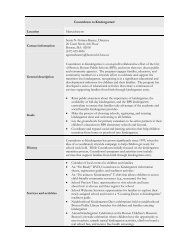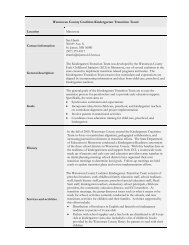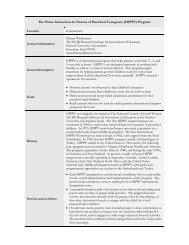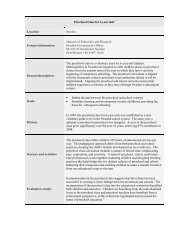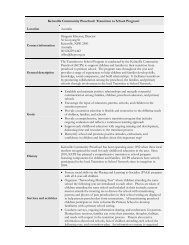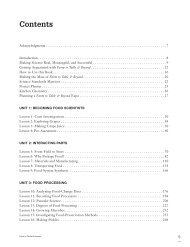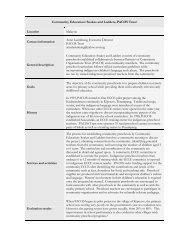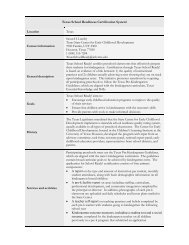Proceedings of the Fourth Annual Teachers College Educational ...
Proceedings of the Fourth Annual Teachers College Educational ...
Proceedings of the Fourth Annual Teachers College Educational ...
You also want an ePaper? Increase the reach of your titles
YUMPU automatically turns print PDFs into web optimized ePapers that Google loves.
Credibility <strong>of</strong> Culturally Situated Design Tools:<br />
Ma<strong>the</strong>matics and Black Identity<br />
Raymond Lutzky,<br />
Rensselaer Polytechnic Institute, 110 Eighth Street, Troy, NY<br />
Email: lutzkr3@rpi.edu<br />
Abstract: Social identities and stereotypes <strong>of</strong> Black culture significantly impact education<br />
and student learning in American schools (Ogbu and Simons, 1998; Steele et al., 2002),<br />
Strategies to combat <strong>the</strong>se social paradigms, such as “peer pro<strong>of</strong>ing” <strong>of</strong> students, may<br />
only serve to exacerbate <strong>the</strong> racial divide between black and white and fur<strong>the</strong>r alienate<br />
African-American students from <strong>the</strong>ir own social identities (Fordham, 1991). This has led<br />
to a variety <strong>of</strong> observable phenomena that negatively impact African-Americans’ selfidentity,<br />
self-confidence, and academic ability. Some have described <strong>the</strong> cultural<br />
implications <strong>of</strong> a student being accused <strong>of</strong> “acting white,” and <strong>the</strong> consequences within<br />
American educational settings (Fryer and Torelli, 2005; Bucholtz, 2001). Unique teaching<br />
strategies, such as <strong>the</strong> use <strong>of</strong> culturally situated design tools (CSDT Web site, 2012),<br />
may hold <strong>the</strong> key in providing African-American students with a way to achieve academic<br />
success without alienating <strong>the</strong>mselves from <strong>the</strong>ir Black peers and cultural identification<br />
(Eglash, 2005). This paper seeks to evaluate culturally situated design tools associated<br />
with Black identity to determine <strong>the</strong> means by which <strong>the</strong>y achieve credibility with <strong>the</strong>ir<br />
audiences and improve student learning.<br />
Black Identity and Education<br />
Social psychological processes play a significant role in <strong>the</strong> academic underperformance <strong>of</strong> stigmatized<br />
minority groups (Steele et al., 2002). This is <strong>the</strong> essence <strong>of</strong> “stereotype threat,” as manifest in Steele’s<br />
research using standardized test scores across different racial groups:<br />
When a negative stereotype about a group that one is part <strong>of</strong> becomes personally<br />
relevant, usually as an interpretation <strong>of</strong> one’s behavior or an experience one is having,<br />
stereotype threat is <strong>the</strong> resulting sense that one can <strong>the</strong>n be judged or treated in terms <strong>of</strong><br />
<strong>the</strong> stereotype or that one might do something that would inadvertently confirm it. (Steele<br />
et al., 2002, p. 389)<br />
Particularly among African Americans, stereotype threat is a very real phenomenon. For example, it has<br />
been demonstrated that stereotype threat influences <strong>the</strong> thought processes and academic performance <strong>of</strong><br />
students – in instances where African-American students believe <strong>the</strong>y are being compared to a White<br />
group, <strong>the</strong>y provided more stereotypical and self-doubting answers than a control group <strong>of</strong> <strong>the</strong> same race.<br />
“Simply expecting to take an ability-diagnostic test was enough to activate racial stereotypes about ability<br />
in <strong>the</strong> minds <strong>of</strong> Black participants,” (Steele et al., 2002). An analysis <strong>of</strong> Black identity and its relationship<br />
to education is required for a deeper understanding <strong>of</strong> this phenomenon, and <strong>the</strong> strategies <strong>of</strong> American<br />
schools to combat it.<br />
The Black identity <strong>of</strong> African-American students is a complex and evolving psychological paradigm. One<br />
relevant <strong>the</strong>ory is that <strong>of</strong> fictive kinship, which Fordham addresses in her ethnography <strong>of</strong> Black<br />
adolescents in American schools. “Fictive kinship indicates a kinshiplike relationship between persons not<br />
related by blood or marriage, who also have some reciprocal social or economic relationship,” (Fordham,<br />
1991). This notion conveys <strong>the</strong> “peoplehood” <strong>of</strong> Black social identity, and she goes on to describe <strong>the</strong><br />
challenges for this identity in modern American schools. However, traditional American institutions <strong>of</strong><br />
education have approached instruction through racially-motivated instances <strong>of</strong> “peer-pro<strong>of</strong>ing,” negatively<br />
affecting students’ identity as Black people. This is evidenced (and exacerbated) by a tendency to<br />
remove high-achieving Black students and place <strong>the</strong>m away from <strong>the</strong>ir Black peers into nearly all-White<br />
environments. Fordham notes that this separation in <strong>of</strong> itself suggests that “<strong>the</strong>y are, in some important<br />
intellectual and nonintellectual ways, different from o<strong>the</strong>r Black people and, with <strong>the</strong> possible exception <strong>of</strong><br />
phenotypical (or racial) features, clones <strong>of</strong> <strong>the</strong>ir White peers,” (Fordham 1991). This is reinforced by<br />
46



